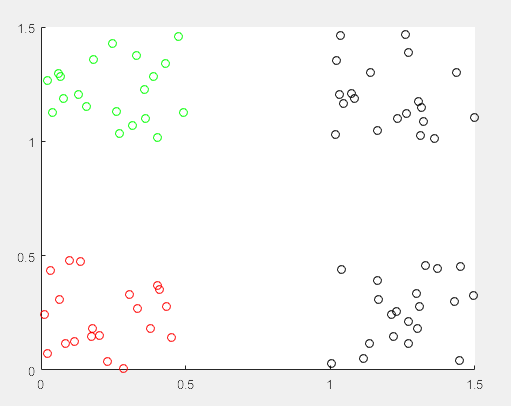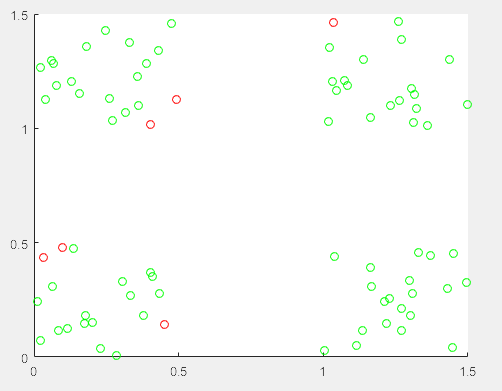BP神经网络的MATLAB实现
来源:互联网 发布:mac作用是什么 编辑:程序博客网 时间:2024/05/17 06:39
算法流程
关于BP神经网络的公式推导,上一篇博文《BP神经网络原理简单介绍以及公式推导(矩阵形式和分量形式) 》已经做了详细的说明。接下来,我们利用MATLAB对BP神经网络进行实现。我们直接上代码,并进行解释。
MATLAB 代码
整个代码是基于BP神经网络矩阵形式编写的,对公式有疑惑的同学可以参考下上篇博文。
sigmoid.m
function [ out ] = sigmoid( in )%SIGMOID Summary of this function goes here% Detailed explanation goes here out = 1./(1+exp(-in));end。Sigmoid的函数一般形式有:
它们导数都是自相关的。我们的激活函数就选择最简单的Sigmoid的函数,
create_w.m
function [ W ] = create_w( n_levels )%CREATE_W Summary of this function goes here% Detailed explanation goes here n_level = numel(n_levels) - 1; W = cell(n_level,1); for i=1:n_level W{i} = ones(n_levels(i+1), n_levels(i)); endend创建权值矩阵,初始值都是1。其中n_levels是一个向量,描述了神经网络的结构,比如
n_levels = [2 6 1]描述了一个2-6-1的网络,也就是输入层2个神经元,隐藏层6个神经元,输出层1个神经元。上篇推导公式博文中的网络可以被描述为6-4-2-2网络。
每一层的权值矩阵与上一层的输入个数和这一层的输出个数有关。
create_theta.m
function [ theta ] = create_theta( levels )%CREATE_THETA Summary of this function goes here% Detailed explanation goes here n_level = numel(levels) - 1; theta = cell(n_level, 1); for i=1:n_level theta{i} = ones(levels(i+1),1); endend创建偏移量矩阵,初始值为1。
BP_predict.m
function [ output, Y ] = BP_predict( input, W, theta)%BP_ Summary of this function goes here% Detailed explanation goes here f = @sigmoid; n_w = numel(W); Y = cell(n_w+1, 1); Y{1} = input'; for i=1:n_w net = W{i}*Y{i} + theta{i}; Y{i+1} = f(net); end output = Y{end};end在训练中,需要对目前的
BP_predict2.m
function [ output] = BP_predict2( input, W, theta)%BP_ Summary of this function goes here% Detailed explanation goes here f = @sigmoid; n_w = numel(W); y = input'; for i=1:n_w net = bsxfun(@plus,W{i}*y,theta{i}); y = f(net); end output = y;endBP_predict2用于预测,可以对一个数据矩阵进行预测。
BP_tranning.m
function [ W,theta ] = BP_tranning( X, levels, step )%BP_TRANNING Summary of this function goes here% Detailed explanation goes here if nargin < 3 step = 0.001; end n_levels = size(levels, 2) - 1; n_input = levels(1); W = create_w(levels); theta = create_theta(levels); [n_data,col] = size(X); n_label = col - n_input; tranning_data = X(:,1:n_input); %Y0 is input label = X(:,n_input+1:end)'; f = @sigmoid; eps = 10e-7; old_error = 0; while true for k=1:n_data [output, Y] = BP_predict(tranning_data(k,:), W, theta); delta = label(:,k) - output; % update the W, from the last layer to the first layer for l=n_levels:-1:1 net = W{l}*Y{l} + theta{l}; if l == n_levels S = diag(f(net).*(1-f(net)))*delta; else S = diag((f(net).*(1-f(net))))*W{l+1}'*S; end %dW = -S*Y{l}'; new_W{l} = W{l} + step*S*Y{l}'; new_theta{l} = theta{l} + step*S; end % end update W = new_W; theta = new_theta; end % end for y = BP_predict2(tranning_data, W, theta); delta = y - label; error = sum(sum(delta.^2)); if abs(error - old_error) < eps; break; else old_error = error; end endend训练的中止条件,个人觉得很难确定。不得已,写了一个不那么合理的:就是通过比较前后两次的错误率,错误率变化很小很小,说明错误率很难降低了,模型趋于稳定了。
其中
测试
demo_3class.m
%% Build a tranning set of three classc_1 = [0 0];c_2 = [0 1];c_3 = [1 0];c_4 = [1 1];n_L1 = 20; % number of label 1n_L2 = 20; % number of label 2n_L3 = 20; % number of label 3A = zeros(n_L1, 4);A(:,3) = 0; A(:,4) = 0;for i=1:n_L1 A(i,1:2) = c_1 + rand(1,2)/2;endB = zeros(n_L2, 4);B(:,3) = 0; B(:,4) = 1;for i=1:n_L2 B(i,1:2) = c_2 + rand(1,2)/2;endC = zeros(n_L3, 4);C(:,3) = 1; C(:,4) = 0;for i=1:n_L3 C(i,1:2) = c_3 + rand(1,2)/2;endD = zeros(n_L3, 4);D(:,3) = 1; D(:,4) = 0;for i=1:n_L3 D(i,1:2) = c_4 + rand(1,2)/2;endscatter(A(:,1), A(:,2),[],'r');hold onscatter(B(:,1), B(:,2),[],'g');hold onscatter(C(:,1), C(:,2),[],'k');hold onscatter(D(:,1), D(:,2),[],'k');X = [A;B;C;D];%% Trainning the BP networkdbstop if errorn_label = 2;% create the weight matrixn_input = size(X,2) - n_label;% number of feature of each data, here is 2, only x-axis and y-axislevels = [n_input 7 n_label];step = 0.1;[W,theta] = BP_tranning(X, levels, step);save three_class W theta%% show the resultinput = X(:,1:n_input);label = X(:,n_input+1:end);y = BP_predict2(input, W, theta);Y = y';Y(find(Y>0.5)) = 1;Y(find(Y<=0.5)) = 0;T = sum(label - Y, 2);error_index = find(T ~= 0);figure;scatter(X(:,1), X(:,2), [], 'g');hold onscatter(X(error_index,1), X(error_index,2), [], 'r');演示了一个三类分类器。对于多类分类,神经网络应该有多个输出,每个输出为0或者1,组合得到结果。比如这个例子,00表示第一类,01表示第二类,10表示第三类。 
上图是初始训练数据,每种颜色代表一类。 
上图是训练之后,对训练集进行预测的结果,其中红色表示错误,绿色表示正确。
总结
整体来说,实现BP算法不难,但是在实验部分却发现模型的选择、step的选择、终止条件的选择都很麻烦。已经隐约感受到调参民工的辛苦了。所有代码可以在这里下载
- BP神经网络的matlab实现
- BP神经网络的MATLAB实现
- BP神经网络的matlab实现
- Matlab实现BP神经网络
- matlab实现BP神经网络
- BP神经网络matlab实现
- MATLAB实现BP神经网络
- Matlab实现BP神经网络
- BP神经网络设计的matlab简单实现
- BP 神经网络的 MATLAB 实现步骤
- bp神经网络及matlab实现
- BP神经网络及MATLAB实现
- bp神经网络及matlab实现
- bp神经网络及matlab实现
- Matlab实现简单BP神经网络
- bp神经网络及matlab实现
- bp神经网络及matlab实现
- BP神经网络及matlab实现
- 第一个JavaScript学习例子
- 对C标准中空白字符(空格、回车符(\r)、换行符(\n)、水平制表符(\t)、垂直制表符(\v)、换页符(\f))的理解
- ubuntu下制作U盘启动盘
- 帧、报文、报文段、分组、包、数据报概念区分
- CodeForces
- BP神经网络的MATLAB实现
- Cows
- CSS3的content属性详解
- 自定义View-从0开始
- SVN关联码云使用方法总结
- 图像处理4_使用 metadata-extractor 修改图片名为拍摄时间
- LVS+Keepalive 构建高可用Web应用
- MaterialDesign的使用
- java基本数据结构之List常用实现类总结


